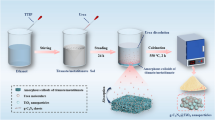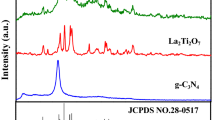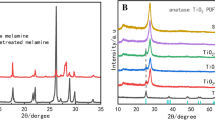Abstract
In this work, an ultrathin 2D/2D g-C3N4/Ti3C2 heterojunction was synthesized by direct calcination of a mixture of urea and multilayer Ti3C2 for photocatalytic degradation of tetracycline. Among them, urea is the precursor for the generation of g-C3N4 and generates gas to peel the multilayer Ti3C2 into fewer layers while reacting, solving the problem of low yield for the preparation of fewer layers of Ti3C2. The experimental results of tetracycline degradation under visible light showed that pure g-C3N4 (UCN) exhibited weak photoactivity; however, its photocatalytic performance was enhanced when Ti3C2 was coupled with g-C3N4. The best sample (5TC) could degrade 90.1% of tetracycline within 30 min. After four cycles of stability test, the photocatalytic performance did not change significantly, indicating that the prepared 2D/2D g-C3N4/Ti3C2 heterojunction possesses strong photocatalytic performance along with good stability.









Similar content being viewed by others
References
X. Li, S. Raza, C. Liu, Preparation of titanium dioxide modified biomass polymer microspheres for photocatalytic degradation of rhodamine-B dye and tetracycline. J. Taiwan Inst. Chem. Eng. 122, 157–167 (2021)
Y. Fang, X. Wu, M. Dai, A. Lopez-Valdivieso, S. Raza, I. Ali, C. Peng, J. Li, I. Naz, The sequestration of aqueous Cr(VI) by zero valent iron-based materials: from synthesis to practical application. J. Clean. Prod. 312, 127678 (2021)
X. Li, S. Raza, C. Liu, Directly electrospinning synthesized Z-scheme heterojunction TiO2@Ag@Cu2O nanofibers with enhanced photocatalytic degradation activity under solar light irradiation. J. Environ. Chem. Eng. 9, 106133 (2021)
W. Sun, J. Jia, C. Jin, X. Zhang, E. Liu, J. Fan, In situ synthesis of Cu3P/g-C3N4 heterojunction with superior photocatalytic hydrogen evolution. J. Phys. D Appl. Phys. 52, 465106 (2019)
P. Karthik, T.R. Naveen, B. Kumar, Redox couple mediated charge carrier separation in g-C3N4/CuO photocatalyst for enhanced photocatalytic H2 production. Int. J. Hydrogen Energy. 45, 7541–7551 (2020)
T. Su, Z.D. Hood, M. Naguib, L. Bai, S. Luo, C.M. Rouleau, I.N. Ivanov, H. Ji, Z. Qin, Z. Wu, 2D/2D heterojunction of Ti3C2/g-C3N4 nanosheets for enhanced photocatalytic hydrogen evolution. Nanoscale 11, 8138–8149 (2019)
M. Shao, Y. Shao, J. Chai, Y. Qu, M. Yang, Z. Wang, M. Yang, W.F. Ip, C.T. Kwok, X. Shi, Z. Lu, S. Wang, X. Wang, H. Pan, Synergistic effect of 2D Ti2C and g-C3N4 for efficient photocatalytic hydrogen production. J. Mater. Chem. A. 5, 16748–16756 (2017)
Y. Sun, D. Jin, Y. Sun, X. Meng, Y. Gao, Y. Dall’Agnese, G. Chen, X.-F. Wang, G-C3N4/Ti3C2Tx (MXenes) composite with oxidized surface groups for efficient photocatalytic hydrogen evolution. J. Mater. Chem. A 6, 9124–9131 (2018)
Q. Liu, J. Shen, X. Yu, X. Yang, W. Liu, J. Yang, H. Tang, H. Xu, H. Li, Y. Li, J. Xu, Unveiling the origin of boosted photocatalytic hydrogen evolution in simultaneously (S, P, O)-codoped and exfoliated ultrathin g-C3N4 nanosheets. Appl. Catal. B 248, 84–94 (2019)
P. Xiao, D. Jiang, T. Liu, D. Li, M. Chen, Facile synthesis of carbon-doped g-C3N4 for enhanced photocatalytic hydrogen evolution under visible light. Mater. Lett. 212, 111–113 (2018)
Y. Zhu, T. Wang, T. Xu, Y. Li, C. Wang, Size effect of Pt co-catalyst on photocatalytic efficiency of g-C3N4 for hydrogen evolution. Appl. Surf. Sci. 464, 36–42 (2019)
H. Li, Z. Liang, Q. Deng, W. Hou, Band structure engineering of polymeric carbon nitride with oxygen/carbon codoping for efficient charge separation and photocatalytic performance. J. Colloid Interface Sci. 564, 333–343 (2020)
M. Sun, H.X. Guan, W.D. Zhang, Y.X. Yu, Strong organic acid-assistant synthesis of holey graphitic carbon nitride for efficient visible light photocatalytic H2 generation. Int. J. Hydrogen Energy 44, 23091–23100 (2019)
C. Zhou, P. Xu, C. Lai, C. Zhang, G. Zeng, D. Huang, M. Cheng, L. Hu, W. Xiong, X. Wen, L. Qin, J. Yuan, W. Wang, Rational design of graphic carbon nitride copolymers by molecular doping for visible-light-driven degradation of aqueous sulfamethazine and hydrogen evolution. Chem. Eng. J. 359, 186–196 (2019)
A. Savateev, I. Ghosh, B. Konig, M. Antonietti, Photoredox catalytic organic transformations using heterogeneous carbon nitrides. Angew. Chem. Int. Ed. 57, 15936–15947 (2018)
J. Huang, J. Liu, J. Yan, C. Wang, T. Fei, H. Ji, Y. Song, C. Ding, C. Liu, H. Xu, H. Li, Enhanced photocatalytic H2 evolution by deposition of metal nanoparticles into mesoporous structure of g-C3N4. Colloids Surf. A 585, 124067 (2020)
L. Zhang, X. Hao, Y. Li, Z. Jin, Performance of WO3/g-C3N4 heterojunction composite boosting with NiS for photocatalytic hydrogen evolution. Appl. Surf. Sci. 499, 143862 (2020)
Z. Zeng, Y. Yan, J. Chen, P. Zan, Q. Tian, P. Chen, Boosting the photocatalytic ability of Cu2O nanowires for CO2 conversion by MXene quantum dots. Adv. Funct. Mater. 29, 1806500 (2019)
N. Li, X. Chen, W.J. Ong, D.R. MacFarlane, X. Zhao, A.K. Cheetham, C. Sun, Understanding of electrochemical mechanisms for CO2 capture and conversion into hydrocarbon fuels in transition-metal carbides (MXenes). ACS Nano 11, 10825–10833 (2017)
C. Peng, X. Yang, Y. Li, H. Yu, H. Wang, F. Peng, Hybrids of two-dimensional Ti3C2 and TiO2 exposing 001 facets toward enhanced photocatalytic activity. ACS Appl. Mater. Interfaces 8, 6051–6060 (2016)
M. Ye, X. Wang, E. Liu, J. Ye, D. Wang, Boosting the photocatalytic activity of P25 for carbon dioxide reduction by using a surface-alkalinized titanium carbide MXene as cocatalyst. Chemsuschem 11, 1606–1611 (2018)
J. Ran, G. Gao, F.T. Li, T.Y. Ma, A. Du, S.Z. Qiao, Ti3C2 MXene co-catalyst on metal sulfide photo-absorbers for enhanced visible-light photocatalytic hydrogen production. Nat. Commun. 8, 13907 (2017)
Y. Li, S. Yang, Z. Liang, Y. Xue, H. Cui, J. Tian, 1T-MoS2 nanopatch/Ti3C2 MXene/TiO2 nanosheet hybrids for efficient photocatalytic hydrogen evolution. Mater. Chem. Front. 12, 2673 (2019)
G. Jia, Y. Wang, X. Cui, W. Zheng, Highly carbon-doped TiO2 derived from MXene boosting the photocatalytic hydrogen evolution. ACS Sustain. Chem. Eng. 6, 13480–13486 (2018)
L. Tie, S. Yang, C. Yu, H. Chen, Y. Liu, S. Dong, J. Sun, J. Sun, In situ decoration of ZnS nanoparticles with Ti3C2 MXene nanosheets for efficient photocatalytic hydrogen evolution. J. Colloid Interface Sci. 545, 63–70 (2019)
Q. Zhong, J. Liu, Z. Wang, J.B. Ghasemi, G. Zhang, Ti3C2 MXene/Ag2ZnGeO4 Schottky heterojunctions with enhanced photocatalytic performances: efficient charge separation and mechanism studies. Sep. Purif. Technol. 278, 119560 (2021)
N. Liu, N. Lu, Y. Su, P. Wang, X. Quan, Fabrication of g-C3N4/Ti3C2 composite and its visible-light photocatalytic capability for ciprofloxacin degradation. Sep. Purif. Technol. 211, 782–789 (2019)
Acknowledgements
This work was financially supported by the Major Projects of Natural Science Research in Anhui Colleges and Universities (KJ2018ZD050), the University Synergy Innovation Program of Anhui Province (GXXT-2019-017, GXXT-2020-009), Natural Science Foundation of Anhui province (1808085ME129, 1908085MB55, 2108085QE213), Key Research and Development Plan of Anhui Province (202004a05020060, 202003a05020045), Outstanding Young Talents Support Program in Colleges and Universities (gxyqZD2018056) and Natural Science Foundation of Anhui Provincial Education(KJ2020ZD44, KJ2019A0776), National College Students' innovation and entrepreneurship training program (202210878047).
Author information
Authors and Affiliations
Corresponding authors
Ethics declarations
Conflict of interest
The authors declare no conflict of interest.
Additional information
Publisher’s Note
Springer Nature remains neutral with regard to jurisdictional claims in published maps and institutional affiliations.
Rights and permissions
Springer Nature or its licensor (e.g. a society or other partner) holds exclusive rights to this article under a publishing agreement with the author(s) or other rightsholder(s); author self-archiving of the accepted manuscript version of this article is solely governed by the terms of such publishing agreement and applicable law.
About this article
Cite this article
Qiao, LL., Zhang, FJ., Kai, CM. et al. Preparation of 2D/2D g-C3N4/Ti3C2 MXene composites by calcination synthesis method for visible light photocatalytic degradation of tetracycline. J. Korean Ceram. Soc. 60, 790–797 (2023). https://doi.org/10.1007/s43207-022-00269-y
Received:
Revised:
Accepted:
Published:
Issue Date:
DOI: https://doi.org/10.1007/s43207-022-00269-y




